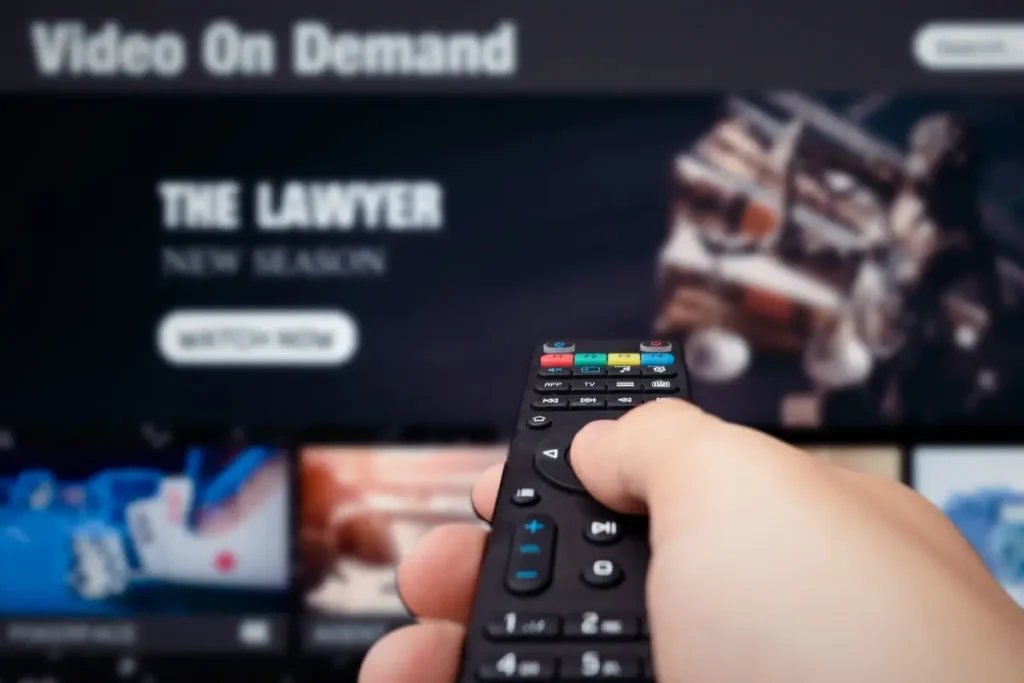By Chris Wilson
As someone who’s spent the last five years exploring various streaming options across the United States, I’ve witnessed firsthand how Internet Protocol Television (IPTV) has transformed the way Americans consume media. After countless hours testing different services, devices, and setups, I’m excited to share my complete guide to help you navigate the world of IPTV in the USA.
Table of Contents
Introduction: What is IPTV and Why It’s Gaining Popularity in the USA
IPTV, or Internet Protocol Television, delivers television content over internet protocol networks instead of through traditional satellite or cable formats. Unlike conventional broadcasting, IPTV streams media content directly to your device using your internet connection, offering on-demand access to your favorite shows, movies, and live channels.
The popularity of IPTV in the United States has skyrocketed in recent years, and it’s not difficult to understand why. As Americans increasingly seek flexible, cost-effective alternatives to traditional cable packages, IPTV has emerged as a compelling solution that puts viewers in control of their entertainment experience.
During my transition from an expensive cable subscription to IPTV services, I discovered numerous advantages that convinced me this technology represents the future of television consumption in America.

Why Choose IPTV in the USA? The Compelling Benefits
Substantial Cost Savings
Perhaps the most immediate benefit I noticed after switching to IPTV was the significant reduction in my monthly entertainment expenses. Traditional cable packages in the USA typically range from $60 to $150 per month, often with contractual obligations and hidden fees. In contrast, legitimate IPTV services generally cost between $20 and $50 monthly, potentially saving households hundreds of dollars annually.
Unparalleled Content Variety
The content libraries available through IPTV services extend far beyond what’s accessible through conventional cable packages. While testing various platforms, I gained access to:
- Thousands of national and international channels
- Extensive on-demand content libraries
- Specialized niche programming not available on traditional networks
- Regional channels from across the United States and globally
This diversity allowed me to discover programming I never knew existed, expanding my viewing horizons considerably.
Remarkable Flexibility and Convenience
IPTV liberated me from the rigid scheduling of traditional television. With IPTV, I can:
- Watch content on multiple devices (smart TVs, phones, tablets, computers)
- Access programming from anywhere with an internet connection
- Pause, rewind, and record live television
- Create personalized watch lists and recommendations
- Enjoy time-shifting capabilities to watch shows on my schedule
Superior Picture Quality Options
Many IPTV services now offer content in 4K Ultra HD and HDR formats, delivering visual quality that surpasses what’s available through most cable providers. The difference was immediately noticeable on my 4K television, particularly when streaming nature documentaries and sports events.
No Specialized Equipment Requirements
Unlike cable or satellite services that require proprietary boxes or dishes, IPTV works with devices you likely already own. This elimination of equipment rental fees and installation costs represents another significant area of savings.

Essential Requirements for Starting with IPTV in the USA
Based on my experience, you’ll need three fundamental components to begin your IPTV journey:
1. A Reliable High-Speed Internet Connection
The quality of your IPTV experience depends heavily on your internet connection. Through testing various streaming scenarios, I’ve determined these minimum requirements:
- For standard definition (SD) content: 3-5 Mbps
- For high definition (HD) content: 5-10 Mbps
- For 4K/Ultra HD content: 25+ Mbps
Additionally, consider these internet-related factors:
- Connection stability: Consistent speeds are more important than occasional high peaks
- Data caps: Some ISPs impose monthly data limits that IPTV can quickly consume
- Router quality: Older routers may struggle with multimedia streaming demands
I recommend performing an internet speed test before subscribing to any IPTV service to ensure your connection can handle your viewing expectations.
2. Compatible Devices
The versatility of IPTV is evident in the wide range of devices that support these services. During my IPTV journey, I’ve successfully used:
Streaming Devices
- Amazon Fire TV Stick (my personal recommendation for beginners)
- Roku devices
- Apple TV
- Chromecast with Google TV
- NVIDIA Shield (excellent for power users)
Smart TVs
- Samsung Smart TVs
- LG WebOS TVs
- Sony Android TVs
- TCL Roku TVs
- Vizio SmartCast TVs
Mobile Devices
- iPhones and iPads
- Android phones and tablets
Computers
- Windows PCs
- Mac computers
- Linux systems
Gaming Consoles
- Xbox Series X/S
- PlayStation 5
For newcomers to IPTV, I specifically recommend the Amazon Fire TV Stick 4K for its combination of affordability, performance, and compatibility with most IPTV applications.
3. IPTV Service Subscription
This is perhaps the most critical choice in your IPTV journey. The United States offers numerous legitimate IPTV options, ranging from mainstream streaming services with live TV components to specialized IPTV providers.
You should subscribe to a trustworthy IPTV provider like Smartsgi that offers reliable service, legal content, and good customer support. The right provider makes all the difference in your streaming experience.
4. Essential IPTV Applications
Depending on your chosen service and device, you’ll need specific applications to access your IPTV content. During my exploration, I found these applications particularly useful:
For Legal Streaming Services
- Official apps from major providers
- Network-specific apps from major broadcasting companies
For IPTV Services Using M3U Playlists
- TiviMate (my top recommendation for Android/Fire TV devices)
- IPTV Smarters Pro
- GSE Smart IPTV
- Perfect Player
For Content Organization
- Plex (for managing personal media alongside IPTV)
- Kodi (with appropriate legal add-ons)
- Channels DVR (excellent for recording capabilities)
I personally prefer TiviMate for its intuitive interface, comprehensive feature set, and excellent performance, particularly when paired with a Fire TV device.

Comprehensive Step-by-Step Guide to Configuring IPTV in the USA
Step 1: Selecting a Legal and Reliable IPTV Provider
The foundation of a satisfying IPTV experience is choosing the right service provider. After testing dozens of options, I recommend considering these factors:
Legitimacy and Legal Compliance
Always prioritize services that have proper licensing agreements for the content they distribute. Legal providers in the USA include:
- Traditional streaming services with live TV components
- Network-specific services from major media companies
- Sports-focused services with official league partnerships
- Specialized legal IPTV providers like Smartsgi that maintain proper licensing agreements
When subscribing to a trustworthy IPTV provider, you ensure you’re getting reliable service with legal content and responsive customer support.
Content Selection
Evaluate the channel lineup and on-demand library to ensure they include your must-have channels and programming. Consider:
- Local channels availability (important for news and sports)
- Sports packages (particularly if you follow specific leagues)
- International content (if you enjoy programming from other countries)
- Specialty channels (documentary, lifestyle, children’s programming)
Service Reliability
Research the provider’s uptime, stream quality, and server performance. I recommend:
- Reading independent reviews from current subscribers
- Requesting a trial period before committing to a long-term subscription
- Testing the service at different times of day to evaluate consistency
- Checking if the provider offers multiple server locations for optimal performance
Customer Support
Quality support is essential, especially when troubleshooting technical issues. Look for providers offering:
- 24/7 customer service through multiple channels (chat, email, phone)
- Comprehensive knowledge bases and setup guides
- Active community forums where users share tips and solutions
- Responsive social media presence for addressing concerns
Pricing Structure
Compare pricing models while considering what’s included:
- Monthly subscription costs
- Annual discounts (typically 15-25% savings)
- Channel package tiers
- Maximum number of simultaneous streams
- DVR or recording capabilities (and associated storage limits)
Step 2: Device Setup and Application Installation
Once you’ve selected a provider, the next step is preparing your device. Based on my experience with different hardware, here’s how to proceed with the most common options:
For Amazon Fire TV Devices:
- Ensure your Fire TV is connected to your home Wi-Fi network
- Navigate to the Amazon Appstore
- Search for your IPTV provider’s official app or a compatible IPTV player
- Download and install the application
- If using a third-party application not available in the Appstore:
- Go to Settings > My Fire TV > Developer Options
- Enable “Apps from Unknown Sources”
- Use the Downloader app to install the APK file directly
For Roku Devices:
- From the Roku Home screen, select “Streaming Channels”
- Search for your IPTV provider’s official channel/app
- Select “Add Channel” to install
- Note that Roku has more limitations for third-party applications compared to Fire TV
For Smart TVs:
- Access your TV’s app store (Google Play Store for Android TVs, App Store for Apple TV, etc.)
- Search for and download your provider’s application
- Follow the on-screen installation instructions
- Some smart TVs may require additional steps for third-party apps not available in their official stores
For Mobile Devices:
- Visit the App Store (iOS) or Google Play Store (Android)
- Search for your IPTV provider’s official application
- Download and install the app
- Grant necessary permissions when prompted
Step 3: Configuring Your IPTV Service
After installing the appropriate application, you’ll need to set up your service. The process varies by provider, but typically follows this pattern:
For Subscription-Based Services with Dedicated Apps:
- Launch the installed application
- Select “Sign In” or “Create Account”
- Enter your subscription credentials
- Complete any requested profile information
- Select your preferred content and personalization options
- Adjust streaming quality settings based on your internet capabilities
For M3U Playlist-Based IPTV Services:
- Open your chosen IPTV player application (TiviMate, IPTV Smarters, etc.)
- Navigate to the “Add Playlist” or “Add Provider” option
- Enter the M3U URL provided by your IPTV service or use their QR code scanning option
- Input your username and password if required
- Wait for the playlist to load and channels to populate
- Organize channels into favorites or custom groups for easier navigation
- Configure EPG (Electronic Program Guide) settings for enhanced functionality
Setting Up Multiple Devices:
Most legitimate IPTV services allow streaming on multiple devices simultaneously (typically 2-5 depending on your subscription). To configure additional devices:
- Install the appropriate application on each device
- Use the same account credentials across all devices
- Check your subscription’s simultaneous stream limitations
- Consider using different quality settings on different devices (e.g., higher quality for your main TV, lower quality for mobile devices)
Step 4: Enhancing Your IPTV Experience with VPN and Security Options
While not strictly necessary, a VPN (Virtual Private Network) can significantly improve your IPTV experience. During my testing, I found that using a VPN provided several benefits:
Privacy Protection
A quality VPN encrypts your internet traffic, preventing your ISP from monitoring your streaming activities.
Access to Geo-Restricted Content
Some IPTV content may be region-locked. A VPN allows you to access programming from different geographical areas by connecting to servers in those locations.
Potential Performance Improvement
In some cases, ISPs throttle streaming traffic. A VPN can help bypass these restrictions, potentially resulting in smoother playback.
Setting Up a VPN for IPTV:
- Subscribe to a reputable VPN service with streaming-friendly features
- Install the VPN application on your streaming device
- Connect to a server (preferably one geographically close to you for optimal speed)
- Launch your IPTV application while the VPN connection is active
- Adjust VPN settings to allow automatic connection when your device starts
Additional Security Considerations:
- Use strong, unique passwords for your IPTV subscription accounts
- Enable two-factor authentication if offered by your provider
- Regularly update your streaming devices and applications
- Be cautious about sharing your subscription credentials with others

Understanding IPTV Legality in the United States
The legal landscape surrounding IPTV in the USA can be complex, but understanding the distinction between legal and illegal services is crucial for protecting yourself from potential legal issues.
Legal IPTV Services
Legal IPTV services operate with proper licensing agreements, paying content creators and distributors for the right to broadcast their programming. These services include:
- Mainstream streaming platforms with live TV components
- Network-specific streaming services from major media companies
- Sports-focused streaming platforms with official league partnerships
- Legitimately licensed IPTV providers that maintain proper rights agreements
When you subscribe to a trustworthy IPTV provider like Smartsgi, you can enjoy their services with confidence knowing that you’re accessing properly licensed content.
Identifying Potentially Illegal IPTV Services
During my research, I identified several red flags that may indicate an IPTV service is operating outside legal parameters:
- Unusually low subscription prices (particularly services offering thousands of channels for under $20 monthly)
- Promises of “all premium channels” for a fraction of their collective retail cost
- Absence of a legitimate business address or contact information
- No clear terms of service or privacy policy
- Payment methods limited to cryptocurrency or gift cards
- Social media accounts or websites that frequently change names or disappear
- Services that explicitly advertise themselves as alternatives to paying for legitimate subscriptions
Legal Consequences of Using Unauthorized IPTV
While enforcement typically focuses on service providers rather than individual users, there have been cases of subscribers facing legal consequences. Potential risks include:
- Copyright infringement notices from your ISP
- Account termination by your internet service provider
- Potential civil lawsuits from content rights holders
- Exposure to malware and security vulnerabilities
- Unreliable service quality and customer support
How to Stay Within Legal Boundaries
Based on my experience navigating the IPTV landscape, I recommend these practices to ensure you remain on the right side of the law:
- Choose established, reputable providers with transparent business practices
- Be skeptical of services offering thousands of premium channels at extremely low prices
- Research providers thoroughly before subscribing
- Read terms of service agreements carefully
- Consider whether the pricing aligns with the content offered (if it seems too good to be true, it likely is)
Expert Tips for IPTV Users in the USA
After years of IPTV usage, I’ve compiled these advanced recommendations to enhance your streaming experience:
Optimizing Your Network for IPTV
- Position your router centrally in your home to maximize signal strength
- Consider a mesh network system for larger homes to eliminate dead zones
- Use wired Ethernet connections when possible for more stable streaming
- Implement Quality of Service (QoS) settings on your router to prioritize streaming traffic
- Schedule heavy downloads or uploads during non-viewing hours
Maximizing Picture Quality
- Match your streaming quality settings to your display capabilities
- Enable adaptive streaming options when available
- For 4K content, ensure both your display and streaming device support HDCP 2.2
- Adjust your display’s picture settings specifically for streaming content
- Consider the viewing distance when determining optimal resolution (4K benefits are less noticeable from greater distances)
Managing Multiple Streaming Services
- Use streaming aggregators like Reelgood or JustWatch to track content across platforms
- Create custom profiles for different household members
- Consider rotating subscriptions seasonally based on content availability
- Utilize universal search features available on many streaming devices
Avoiding Common IPTV Scams
Unfortunately, the IPTV market attracts numerous scammers. Watch out for:
- Services requiring payment via non-refundable methods only
- Providers with no trial period options
- Websites with poor grammar, spelling errors, or generic templates
- Unsolicited IPTV offers through social media or email
- Services claiming to offer “lifetime subscriptions” at exceptionally low prices
Staying Current with IPTV Technology
The IPTV landscape evolves rapidly. To stay informed:
- Join reputable IPTV discussion forums and communities
- Subscribe to technology news publications covering streaming developments
- Follow legitimate IPTV service providers on social media for updates
- Regularly check for firmware updates for your streaming devices
Frequently Asked Questions About IPTV in the USA
Throughout my years helping friends and family set up their IPTV systems, these questions consistently arise:
Is IPTV legal in the United States?
Yes, IPTV itself is a technology that is completely legal. However, the legality depends on the specific service you’re using and whether they have proper licensing for the content they distribute. Major streaming services with live TV features and properly licensed providers such as Smartsgi operate legally within the United States.
What internet speed do I need for buffer-free IPTV streaming?
For a smooth experience without buffering, I recommend:
Minimum 10 Mbps for HD content on a single device
25+ Mbps for 4K content or when multiple devices are streaming simultaneously
50+ Mbps for households with heavy streaming usage across several devices
Do I need a smart TV to use IPTV?
No, a smart TV is not required. You can access IPTV services through various devices including streaming sticks (Fire TV, Roku), set-top boxes, computers, tablets, smartphones, and gaming consoles. Any device with internet connectivity and appropriate application support can typically access IPTV content.
Can I watch local channels through IPTV?
Yes, many legitimate IPTV services offer local channels. Some services determine your local channels based on your IP address, while others allow you to select your preferred location. Availability varies by service and region, so check the channel lineup before subscribing.
How does IPTV compare to traditional cable in terms of channel selection?
Legal IPTV services typically offer comparable channel selections to traditional cable packages, often with additional benefits like more on-demand content and better integration with streaming platforms. Some specialized IPTV providers offer international channels that may not be available through conventional cable services.
Can I record shows with IPTV?
Many legitimate IPTV Providers like us include DVR (Digital Video Recorder) functionality, allowing you to record live programming for later viewing. Recording capabilities vary by provider, with differences in storage limits, recording duration, and retention periods.
Will IPTV work with my existing home theater setup?
In most cases, yes. IPTV Subscription can integrate with existing home theater systems through streaming devices connected to your AV receiver or television. Some modern AV receivers even have smart features with direct application support for popular streaming platforms.
How many devices can stream simultaneously with one IPTV subscription?
This varies by provider and subscription tier. Most legitimate services allow between 2-5 simultaneous streams, with options to upgrade for additional concurrent users. Always check this limitation before subscribing, especially for households with multiple viewers.
Do IPTV services offer parental controls?
Most reputable IPTV providers include parental control features allowing you to restrict content based on ratings, create child-friendly profiles, or password-protect mature content. The implementation varies by platform, so investigate specific parental control features if this is important for your household.
What happens if my internet goes down while using IPTV?
Unlike traditional cable, IPTV requires an internet connection to function. If your internet service is interrupted, your IPTV service will be unavailable until connectivity is restored. Some services offer downloaded content for offline viewing, but live programming always requires an active internet connection.
Conclusion: Embracing the Future of Television
My journey from traditional cable to IPTV has been transformative, offering greater flexibility, substantial cost savings, and an expanded content universe. As streaming technology continues to evolve, IPTV represents not just an alternative to conventional television, but its inevitable future.
To begin your own IPTV adventure in the USA:
- Assess your internet connection to ensure it meets streaming requirements
- Choose a compatible streaming device that fits your viewing habits
- Research and subscribe to a trustworthy IPTV provider like Smartsgi
- Install the appropriate applications on your chosen devices
- Optimize your setup for the best possible viewing experience
Remember that the IPTV landscape continues to evolve rapidly, with new services, features, and technologies emerging regularly. Staying informed about these developments will help you maximize your streaming experience while ensuring you remain within legal boundaries.
Whether you’re looking to cut the cord completely or supplement your existing television services, IPTV offers a compelling pathway to a more personalized, flexible, and affordable entertainment experience. The future of television is streaming, and with this guide, you’re well-equipped to embrace it.


